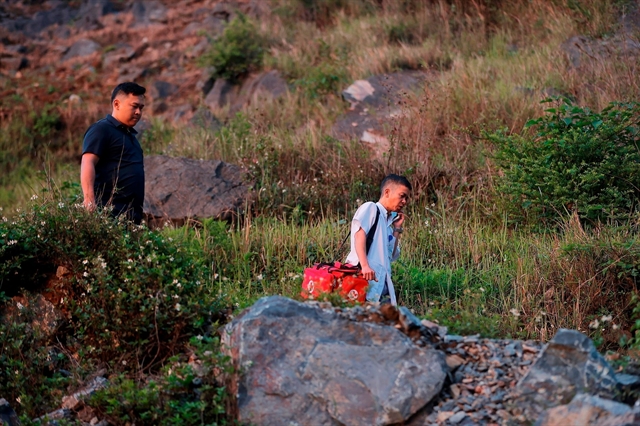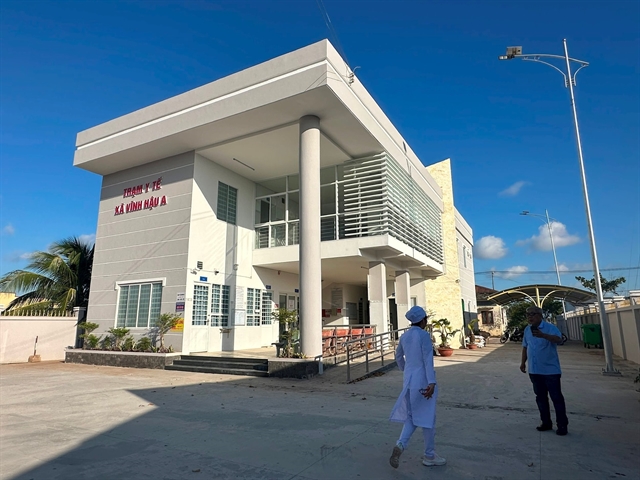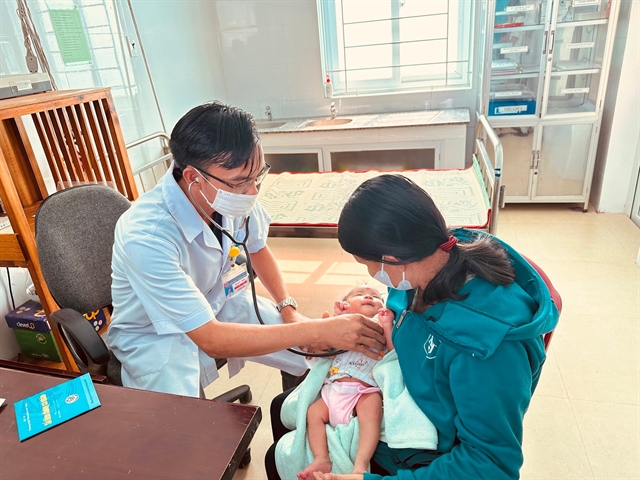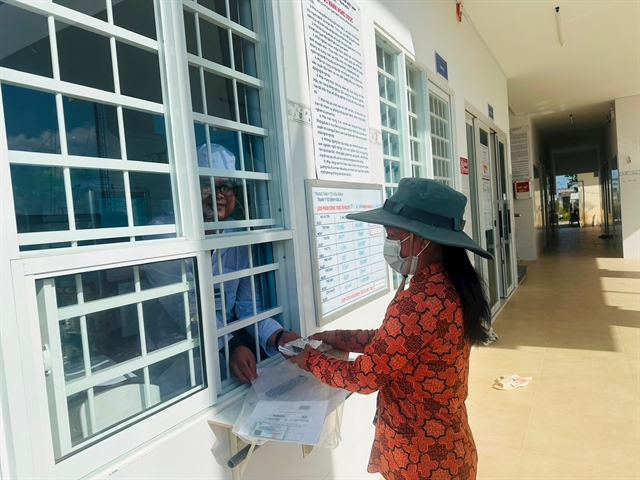Investment needed for breakthroughs in grassroot healthcare
Society – Economy - Ngày đăng : 08:54, 09/11/2024
By Trung Hiền & Thùy Giang
 |
| Dr Nguyễn Duy Đông, head of the Lũng Cú Health Centre in Đồng Văn District in the northern mountainous province of Hà Giang, on his way to give health check-up to local residents. VNA/VNS Photos |
"The grassroots healthcare network is pivotal to providing accessible and affordable healthcare to people across Việt Nam. With sufficient investment, these primary healthcare facilities can fulfil their mission of preventive care and early treatment," Deputy Minister of Health Đỗ Xuân Tuyên has said.
By strengthening the capability of these centres, hospitals can alleviate chronic overcrowding and expand public access to high-quality healthcare services.
New upgrades, new outcomes
The Vĩnh Hậu A Health Centre in Hòa Bình District, Bạc Liêu Province, serves as an example of how local healthcare facilities can make a substantial impact. Led by Dr Phạm Thị Bích Thu, the centre now manages over 1,000 patients with hypertension and 600 with diabetes.
This success in managing chronic diseases is noteworthy, as few health centres have achieved similar results. Dr Thu attributes this to her team’s diligent efforts in patient screenings and outreach, actively encouraging residents to seek health checks for early detection and regular follow-up.
Dr Thu’s approach includes assigning specific staff to designated areas and organising visits to remote villages like Giồng Tra, located 5-6 kilometres away. These visits, scheduled multiple times a year, aim to educate residents and screen for chronic diseases, facilitating early intervention and ongoing management.
The Vĩnh Hậu A Health Centre, a newly constructed two-story facility with 16 rooms, officially opened in January 2024. Operating around-the-clock, the centre provides emergency care, patient monitoring, and referrals for cases that require higher-level hospitalisation.
With a team of eight healthcare staff, the centre serves roughly 600 patients monthly in Vĩnh Hậu A Commune, which has a population of over 9,000 people, 90 per cent of whom are covered by public health insurance.
 |
| The Vĩnh Hậu A Health Centre, located in Hòa Bình District, Bạc Liêu Province, has been newly built to encourage more frequent visits to the centre. |
The centre handles 70-80 per cent of the commune’s hypertension and diabetes cases, also offering maternity care and health monitoring for 70-80 pregnant women annually.
Dr. Thu said that a primary goal is building public trust, which encourages more frequent patient visits and thereby generates stable revenue that benefits both the staff and the community.
“With the centre’s recent upgrades, strengthening our professional skills to meet the community’s needs is crucial,” she said.
“When people trust us, they will seek care more regularly, creating a stable income source and a sustainable future for the health centre.”
Meanwhile, the Cam Tuyền Health Centre in Cam Lộ District, Quảng Trị Province, inaugurated in 2022, has witnessed increased patient visits due to improved facility and equipment.
The two-story centre covers 1,500 square metres and offers a range of services, including medical check-ups, primary care, vaccinations, and health education, serving more than 5,000 households. The facility's six-member team, comprising a physician, a midwife, two nurses, and a pharmacist, now handles 15-17 patients daily, up from 7-10 prior to the upgrades.
Dr. Hoàng Ngọc Đức, head of the Cam Tuyền Health Centre, explained that the new facilities and staff training had expanded their capabilities.
The team can now handle a wider array of procedures, including emergency response, treatment of anaphylactic shock, respiratory issues, high fevers, seizures, bronchitis, and minor surgeries, according to Đức.
 |
| Dr Hoàng Ngọc Đức, head of Cam Tuyền Health Centre, examines a baby patient at the centre in Cam Lộ District, Quảng Trị Province. |
In the past, even minor cases had to be referred to higher-level hospitals, as the centre’s old, deteriorating facilities discouraged visits. With the improved infrastructure, people benefit from comfortable amenities, such as fans and seating in waiting areas, as well as spacious exam rooms, post-vaccination monitoring, and day-stay rooms.
Public health’s 'gatekeepers'
The Ministry of Health reports that Việt Nam has over 11,400 health centres across its communes, wards, towns, and villages.
Statistics show growing public use of these grassroots services, with health insurance-covered visits at primary care facilities increasing from 86 million in 2012 to 113 million in 2022, accounting for over 70 per cent of total national healthcare visits.
Traditional medicine services remain popular, making up 14.6 per cent of district-level visits and 30.5 per cent at the commune level.
A recent oversight report by the National Assembly’s Social Affairs Committee highlighted the extensive reach of Việt Nam’s grassroots healthcare network.
Currently, 99.6 per cent of communes, wards, and townships have a healthcare centre, and 92.4 per cent have at least one medical doctor. District-level healthcare staff make up 34.6 per cent of total healthcare personnel, with commune-level staff comprising 15.8 per cent. The report said that public satisfaction is increasing, particularly regarding the quality and attitudes of healthcare workers.
Phan Lê Thu Hằng, deputy director of the health ministry’s Planning and Finance Department, noted that Việt Nam’s grassroots healthcare network had been systematically organised to provide extensive coverage, serving as the “gatekeepers” of public health. Health centres operate in every commune, providing essential services to the community and helping regulate the healthcare system.
Minister of Health Đào Hồng Lan said that the Party and State had strengthened this grassroots network, recognising it as the backbone of the country’s healthcare system.
The National Assembly passed a resolution in July 2021 to allocate VNĐ24.13 trillion (US$952 million) for public healthcare from 2021 to 2025. Moreover in January 2022 it added VNĐ14 trillion ($552 million) for primary healthcare construction and renovation.
In April 2024, Deputy Prime Minister Trần Hồng Hà approved a plan to elevate primary healthcare quality. This plan aims to ensure every health centre has at least one permanent doctor and includes policies to attract skilled professionals to remote and underserved areas.
The initiative’s goals include providing health insurance coverage for over 95 per cent of those using primary care services and establishing managed health profiles for over 95 per cent of the population. High-risk individuals will receive annual health checks, aiming for routine health assessments for all citizens.
Investing for transformative change
According to deputy director Hằng, about 80 per cent of patients require only primary care, while just 20 per cent need hospitalisation. Overcrowding in central hospitals stems from both limited specialised services and high patient demand. To balance supply and demand, strengthening grassroots capacity is essential.
 |
| Nguyễn Thị Nhâm, resident in Vĩnh hậu A Commune, waiting for her medicine at the Vĩnh Hậu A Commune's Health Centre. |
"Strengthening primary healthcare can control demand for central hospitals' services, creating a balanced, efficient healthcare system," Hằng said.
She suggested a focus on disease prevention, health promotion, and managing chronic conditions at the community level to reduce the need for higher-level care. This approach prioritises integrated, long-term health management with an emphasis on preventing health risks.
However, Deputy Health Minister Đỗ Xuân Tuyên pointed out that many health centres in remote areas are severely deteriorating, hampering effective service delivery. Local funds alone are inadequate to resolve these problems, underscoring the need for stronger support from the Government.
Trần Quang Mạnh, director of Yên Bái City Health Centre, said that some health stations in Yên Bái City, including Nam Cường, Hồng Hà, and Nguyễn Thái Học, were prone to flooding. The Nam Cường Health Station, located in a low-lying area, must move equipment to higher floors during storms, limiting its capacity to serve inpatients.
Tuyên said the Ministry of Health was urgently assessing grassroots needs, with plans to propose necessary investments through 2030.
“Upgrading grassroots healthcare requires comprehensive policies with strong investment in both human and financial resources,” he said.
He urged local authorities to enhance medical capabilities at the grassroots level, implement electronic health records, and raise public awareness of disease prevention.
The ministry also sought increased support to upgrade infrastructure, provide essential medical supplies, and enhance services, building public trust and advancing commune-level healthcare reform. VNS
